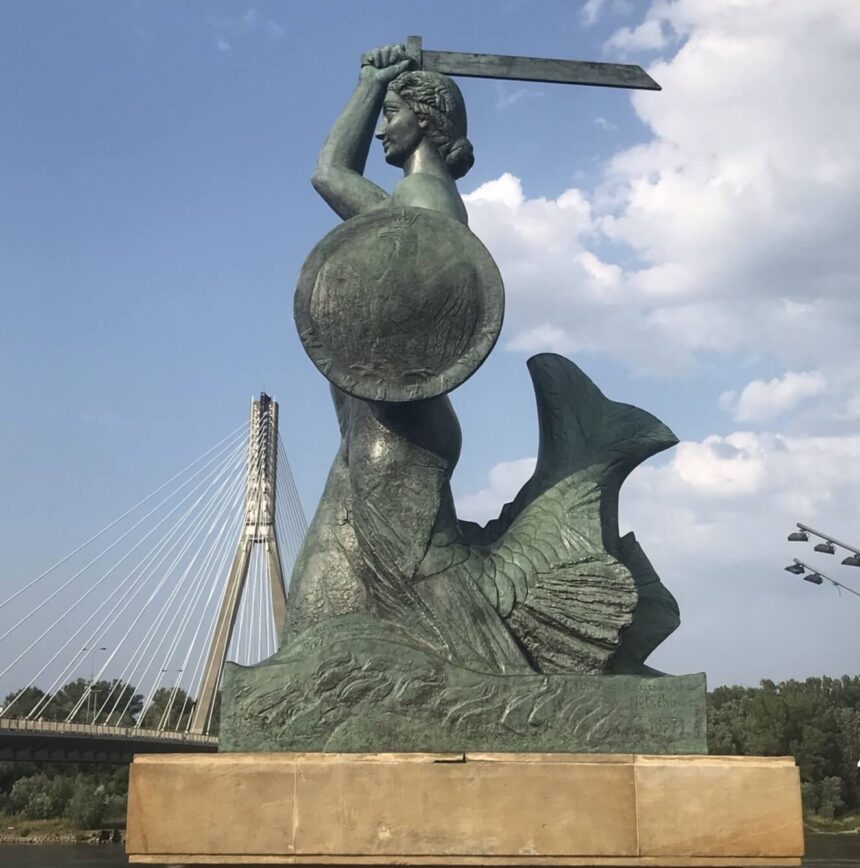by Karolina Szymankiewicz
Warsaw, the capital of Poland and a vibrant metropolis, is located in the very centre of the country. It was precisely because of its location, among other reasons, that it was chosen as the new capital in 1596. Situated on the Vistula River in the Mazovia region, Warsaw is now Poland’s largest and most populous city. It also attracts tourists from home and abroad, offering them a variety of attractions. Various legends, tales and stories are associated with the capital, as with any city with a long history. One of these is the legend of the Mermaid, which has become a symbol of Warsaw. The objects, monuments and activities referring to this fantastic character have in many cases acquired the status of cultural heritage. The Mermaid with a shield and a sword can be found in the city’s coat of arms, as well as in the city’s space, such as monuments, buildings and even entire architectural complexes named after her. I invite you to take a walk around Warsaw in the footsteps of the Mermaid. We will look at the façades of buildings, visit museums, sit on the banks of the Vistula and stop at souvenir stalls in search of this fantastic creature, who only at first glance seems to have nothing to do has nothing to do with the Polish capital.
Legends and stories, tradition and attachment
Before we set off, let us listen to the legend. There are several versions of it, but they all have in common the mermaid and the fishermen working on the Vistula River. The stories go back to distant times, when in the place of today’s metropolis there was only a small village on the banks of the Vistula, surrounded by forests and fields. One of the legends is also connected with the etymology of the city’s name. It features a young fisherman named Wars, who worked hard on the river. One day, when he was out fishing, he saw a beautiful girl with long hair and a fish tail emerge from the water, whose singing enchanted him. From then on, he waited every day for her to appear and listened to her song hiding among the reeds. However, one day he accidentally moved, which caused the plants to rustle. The mermaid spotted Wars and swam closer. The fisherman and the mermaid fell in love, and when the mermaid came ashore, she turned into a human. According to legend, Wars and the mermaid, whose name was Sawa, lived together in a small settlement on the banks of the Vistula, and their names gave rise to the name of the later city of Warsaw (Warszawa).
In another version of the legend, the action also takes place on the banks of the Vistula. Here, too, there are fishermen who lived modestly, and who gave some of what they caught to the Mazovian princes, to whom the land belonged. While on the river, the fishermen sometimes heard a beautiful song, and those who came closer could see a woman with a fish tail between the waves. Once, a few of them thought that if they could capture the beautiful creature and return her to the court of the Mazovian princes, they would surely receive a reward. These fishermen plugged their ears with wax to prevent the woman from enchanting them with her voice. As soon as she emerged from the waves, they cast their nets at her. The mermaid cried and begged the men to let her go, but the men did not even hear her pleas. They left her in the care of the youngest of them and moved away to prepare the carriage. The young fisherman saw that the mermaid was opening her mouth with a pleading expression, so he took the wax out of her ears. He listened to her request and, enchanted, decided to set her free. When the other fishermen returned to the riverbank and saw that the mermaid had disappeared, they were enraged. Frightened, the boy jumped into the Vistula following the fantastic creature. The mermaid was already far away, she turned only for a moment and addressed her last words to the men: “I sang for you and wanted to warn you of danger, and you caught me in a net and trapped me! Therefore, I am sailing away forever. If I return, it will be with shield and sword to defend you from danger. But only if you cannot cope for yourselves.” These were the last words of the mermaid who disappeared among the waves and has not returned to this day. The settlement on the Vistula grew and, after many years, it was established as the capital of Poland. Many years passed, but the people of Warsaw did not forget the mermaid who had promised her help. To this day, on the banks of the Vistula, near the Świętokrzyski Bridge, stands a statue of the mermaid with a raised sword and shield.
Warsaw sirens on bridges and viaducts – link to water
It is here that we begin our journey – for it was here, on the banks of the Vistula, that the legend described was to take place. Exactly at this location is the first example on our route of the Warsaw Mermaid in urban space. It is a bronze-cast monument, which together with its plinth measures 6 metres. It was designed by the sculptor Ludwika Nitschowa, and cast by the famous Warsaw workshop of the Łopieński brothers. The ceremonial erection of the monument took place in 1939. The statue faithfully depicts the Mermaid’s help announced in the legend – she emerges from the waves with a round shield and a raised sword. The fact that the monument was not destroyed during World War II can be read symbolically. Throughout the occupation of Warsaw, it stood on the Vistula River, almost in the very centre of the city. During the Warsaw Uprising, it suffered little damage, but after the end of hostilities, it was renovated. The riverfront, where the monument has stood for many years, is known as the Vistula Boulevards (Bulwary Wiślane). Nowadays, it is a meeting place for crowds of Varsovians, who sit in groups on the concrete steps next to the Mermaid, a landmark and symbol of the whole area. It is worth mentioning that near the monument is the Świętokrzyski Bridge, which was built on the site of a former temporary structure, known as the Mermaid Bridge. It was erected in 1985 during the renovation of the nearby Prince Józef Poniatowski Bridge to temporarily facilitate car traffic across the river. Today, only relics of the Mermaid Bridge can be seen – on the Praga district side, only the bridge’s reinforced concrete supports have survived, partly incorporated into a bouldering climbing wall erected in 2017. The very idea of naming the bridge after a Mermaid is a great example of the importance this symbol has acquired in the eyes of the city’s inhabitants.
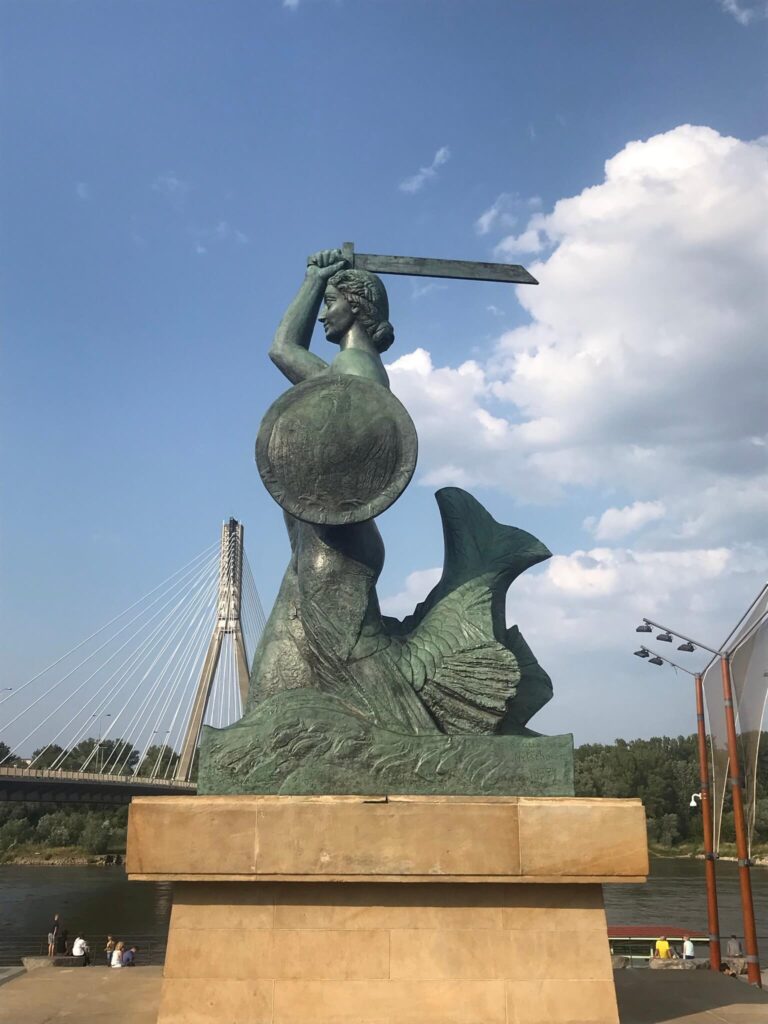
A bas-relief with a Mermaid can also be found in the sculptural decoration of the aforementioned Poniatowski Bridge. The bridge was built between 1904 and 1914 to a design by engineers Mieczysław Marszewski, Bronisław Plebiński and Wacław Paszkowski. The architectural design of the bridge and viaduct was created by Stefan Szyller. Originally, the towers and turnpikes at the entrance to the bridge were intended to have a defensive function, but today they are primarily decorative. A medallion with a bas-relief figure of a Mermaid with a sword and shield, framed in carved acanthus leaves, was placed on the top of one of the tollgates. It is an obvious reference to the city’s coat of arms, but once again the figure of the Mermaid was placed on a bridge – an object associated with the Vistula River.
Another Mermaid statue is associated with architectural structures of this kind. It is located on the Stanislaw Markiewicz Neo-Renaissance viaduct over Karowa Street. It was built between 1902 and 1905, with the design of the structure created by engineer Karol Sommer, the architecture by Stefan Szyller, and Jan Woydyga designing the sculptural decoration. Woydyga was also the author of the sandstone sculpture of a Mermaid. It is more expressive than the Vistula River monument, but has the same attributes – a raised sword and a round shield. The Mermaid looks down on passing vehicles and pedestrians, and her face has a very serious, perhaps even slightly gloomy, expression. In addition to her, there are other sculptures on the bridge. One is a sculptural composition with a woman symbolising Warsaw wearing a crown made from the outline of the city walls, who holds a book in one hand and attributes of science and art in the other. Next to her sits a man with a cogwheel and a sword, an allegory of work. Above them is a wreath-decorated column with a burning candle, symbolising education. Next to it, a menacing-looking man with a wavy beard and long hair is an allegory of the Vistula River. In 1965, the viaduct and its sculptural decoration were entered in the Register of Historic Monuments, and in 2006-2007 the entire structure underwent a major renovation.
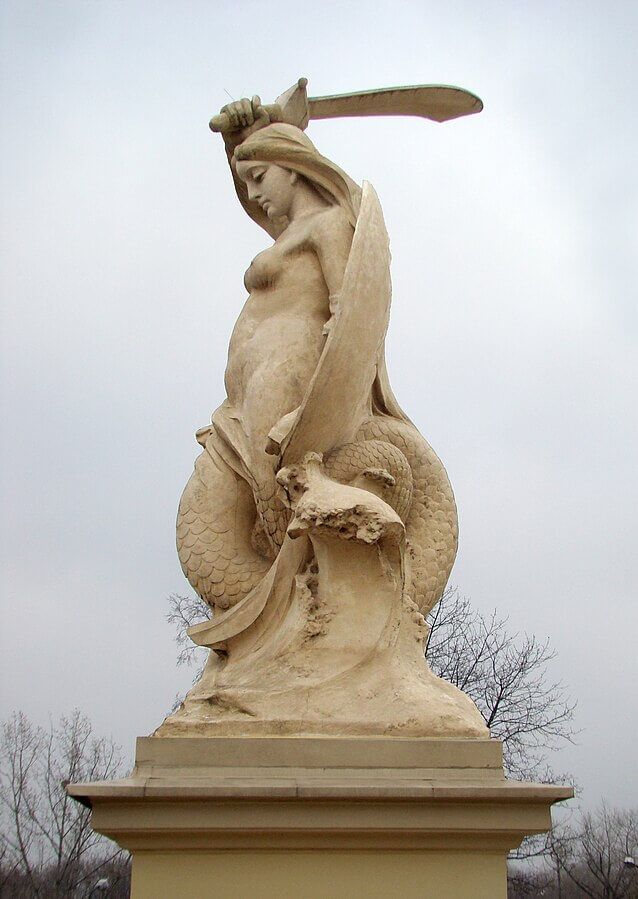
Tracking down Mermaids in the Old Town
We continue on the trail of monuments boasting a Mermaid. The next one is located in the market square of the Old Town (Starowka). It is a charming place that attracts many tourists. In the middle of the square, there is a statue which resembles the Mermaid from the Vistula Boulevards. Designed by Konstanty Hegel, the tin casting was made in connection with the construction in 1851-1855 of the first modern water supply system in Warsaw, designed by Henryk Marconi. The water features of this construction, which were located in the most representative parts of the city, were decorated with water-related ornamentation – figures of fish, tritons, dolphins and, among them, the Warsaw Mermaid. This element had already been intended for the Old Town Square since 1855, and although it changed its location several times, it was eventually returned to its original place (symbolically, because for conservation reasons, the original is kept in the Museum of Warsaw, and a faithful copy has been placed in the square). The historical function of the statue has been emphasised by integrating it into the structure of the fountain – now, at its base, there is a circular depression, with trickles of water gushing towards the Mermaid from holes placed on the edges of the basin. This casting is the oldest monument to the Warsaw Mermaid and set a pattern repeated by subsequent sculptors. The Old Town Mermaid has an expressive, decorative form, aided by a strongly reclining torso and a twisted, finely scaled fish tail emerging from the foaming waves. She, too, wields a high-handed sword and a round shield. She has classical facial features, her head raised proudly and her gaze directed into the distance, above the rooftops of the townhouses, as if to show us the way for further explorations of Warsaw’s Mermaids.
However, we are still in the Old Town Square for a while. The mermaid motif is repeated many times on the facades of the townhouses; you just have to strain your eyes and be patient. One in particular is worth mentioning – at the top of one of the tenement houses there is a metal weathervane, consisting of a figure of a Mermaid with a sword and shield and the ornamental date 1953 (the year in which the first stage of reconstruction of Warsaw’s Old Town after wartime damage was completed). In this case, the fantastic figure differs from the sculptural versions because, in addition to a curved fish tail, it also has bird-like claws, thus coming close to the sirens of Greek mythology. The Old Town Square is also home to the Museum of Warsaw, which is well worth a look in search of more Mermaid motifs. The museum houses the original of the previously described monument, as well as many examples of Warsaw craftsmanship, whose makers were fond of referencing the legend of the Mermaid. The figure of the Mermaid appears on ceramics, glass and even silver tableware. At the very entrance to the exhibition, visitors can see examples of the city’s coat of arms, with a silhouette of the Mermaid on it, as well as its transformation over the years.
Another museum in which the figure of a Mermaid appears is the Museum of Pharmacy, located at 31/33 Piwna Street. On the façade of this building hangs a metal signboard in the shape of a coat of arms, in which a slender silhouette of a woman with a fish tail is placed. She holds up a strand of her hair in one hand and a long golden snake in the other, a reference to medicine and the museum exhibition located there. In the same street, on the Book House building, there is another metal signboard with a Mermaid figure. Here, too, the Mermaid, in addition to a fish tail, has bird claws resting against the base of the signboard, as well as dragon wings. However, the traditional details have not changed and the fantastic figure is equipped with a sword and shield.
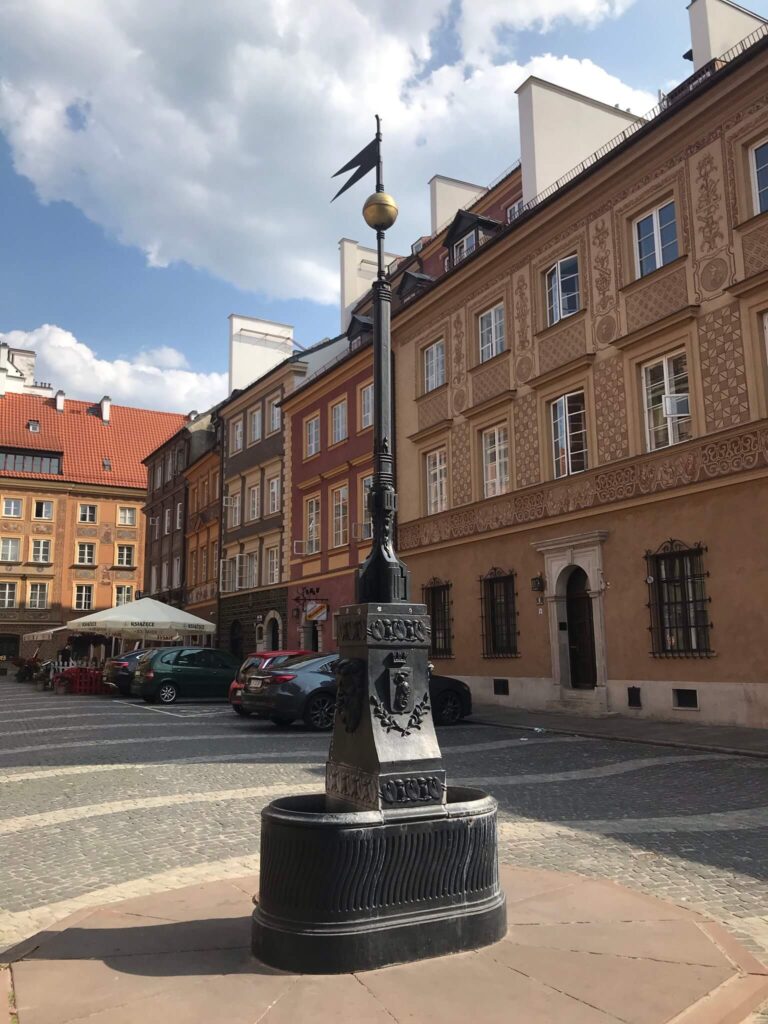
Let’s now head to the Broad Danube Square (Plac Szeroki Dunaj) located within this district. The square takes its name from the Danube stream that once flowed here. It was in this stream that, according to some versions of the legend of Wars and Sawa, a Mermaid swam. Today, a well bearing her image stands in place of the spring. It can also be seen on the façade of a building on the same square, known as the Hangman’s House (Dom Kata), which now houses the Guild of Arts and Crafts. It is a bas-relief made in 1963 by Henryk Gaczyński. The artist gave the Mermaid an abstract form, incorporating her figure into various geometric shapes. The second version of the legend of the Warsaw Mermaid is referred to in the decoration of the façade of a tenement house at 8 Kościelna Street. It is located outside the Old Town (in the Praga Południe district). Made in the 1950s, it was designed by Zofia Czarnocka-Kowalska, who created it in sgraffito technique. Here we see a Mermaid entangled in a fishing net, held on either side of her by two fishermen. The composition is symmetrical and the figures themselves have characteristics of so-called folk art. (tak zwana sztuka ludowa), which most often include geometrisation, simplification and decorative elements.
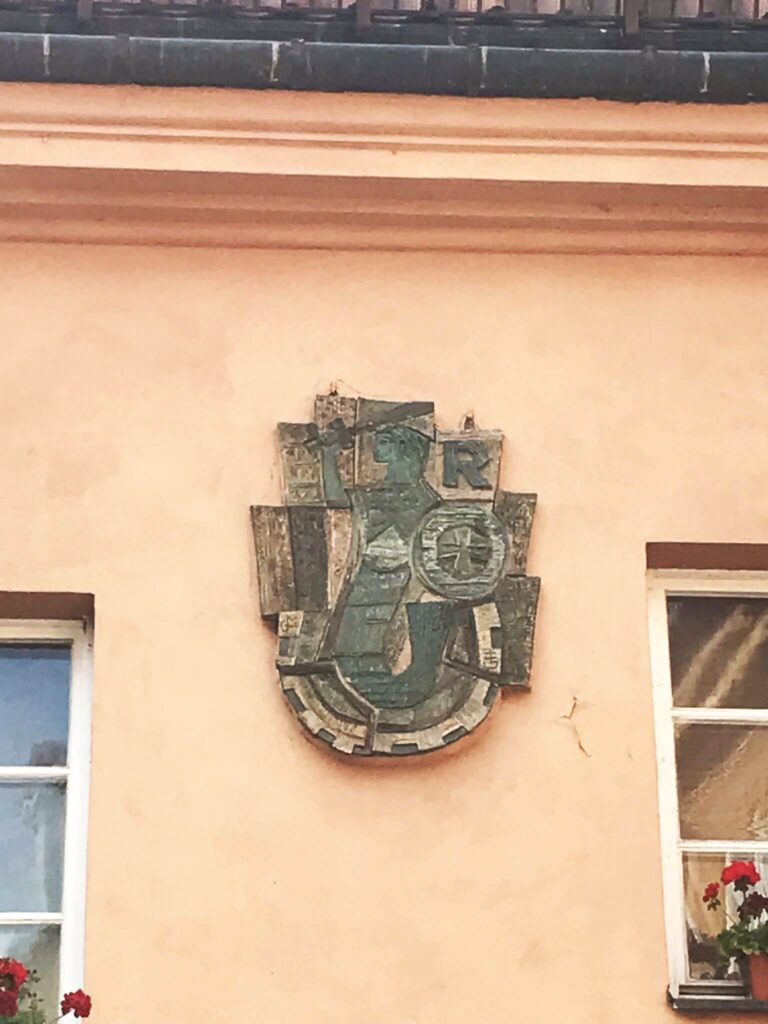
A similar, geometrised form was adopted by the Mermaids in the façade decoration of the tenement house at 10 Castle Square (Plac Zamkowy). This modernist building was constructed between 1963 and 1970 to a design by Jan Bogusławski and Bohdan Gniewiewski. The author of the decoration, executed in sgraffito technique, is Czesław Wielhorski. The figure of the Mermaid appears here several times, sometimes holding the traditional sword and shield, and sometimes a spiralled shell – a symbol of water. In addition, the entire façade is decorated with a geometric pattern reminiscent of fish scales. Narrow streets, filled with shops and small restaurants, diverge from Castle Square. One of these, Świętojańska Street, is home to St John’s Cathedral. Looking at the bronze doors that lead into its interior. These date from the post-war rebuilding of the church in 1963, and were designed by Stanisław Marzyński, who also directed the rebuilding of the entire cathedral. The doors have been divided into small square panels in which the most important scenes from the history of the Catholic Church have been placed. Interestingly, there was also a place here for a symbolic reference to the history of Warsaw. This was done by depicting in several panels the figure of a Mermaid with a raised sword and a round shield, thus illustrating the transformation of the city’s coat of arms in different periods.
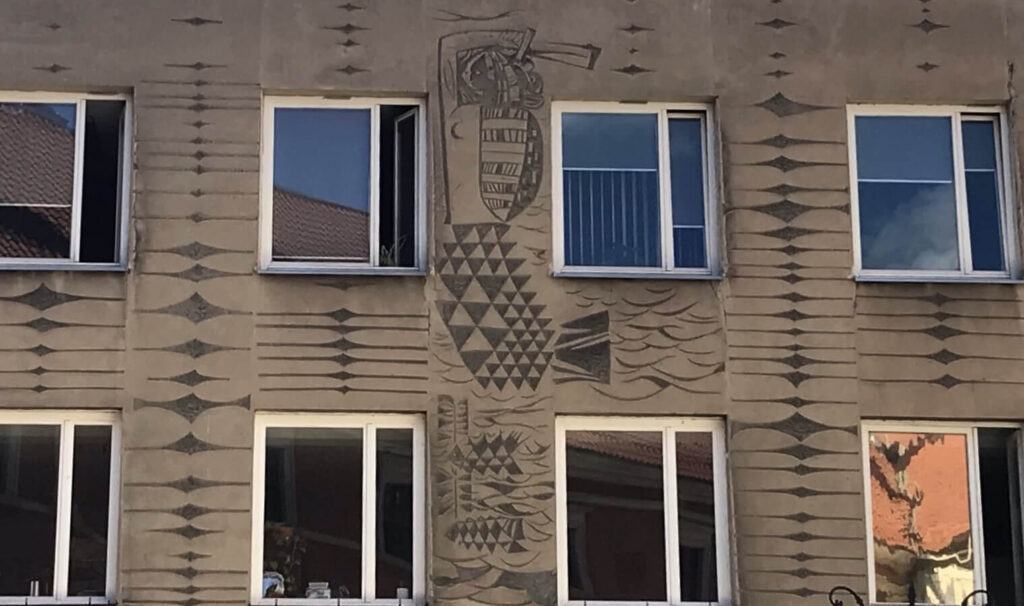
From the Castle Square, we can stroll along the wide Krakowskie Przedmieście Street, where there are also examples of the use of the Mermaid figure in the decoration of tenement houses. One noteworthy example is the façade of the Tenement House of the Tailors’ Guild, where the Mermaid has been placed on a stone coat of arms with the date 1390, with scissors below her, alluding to tailoring. The Mermaid in the coat of arms is also on the façade of the Jabłonowski Palace. To reach it, we have to turn off Krakowskie Przedmieście Street and walk to nearby Senatorska Street. The building was constructed in the second half of the 18th century by the famous architects Dominik Merlini and Jakub Fontana. The Mermaid was placed in an ornamental frame above one of the window openings. This form of depiction of the Warsaw Mermaid appears repeatedly because of its reference to the city’s coat of arms.
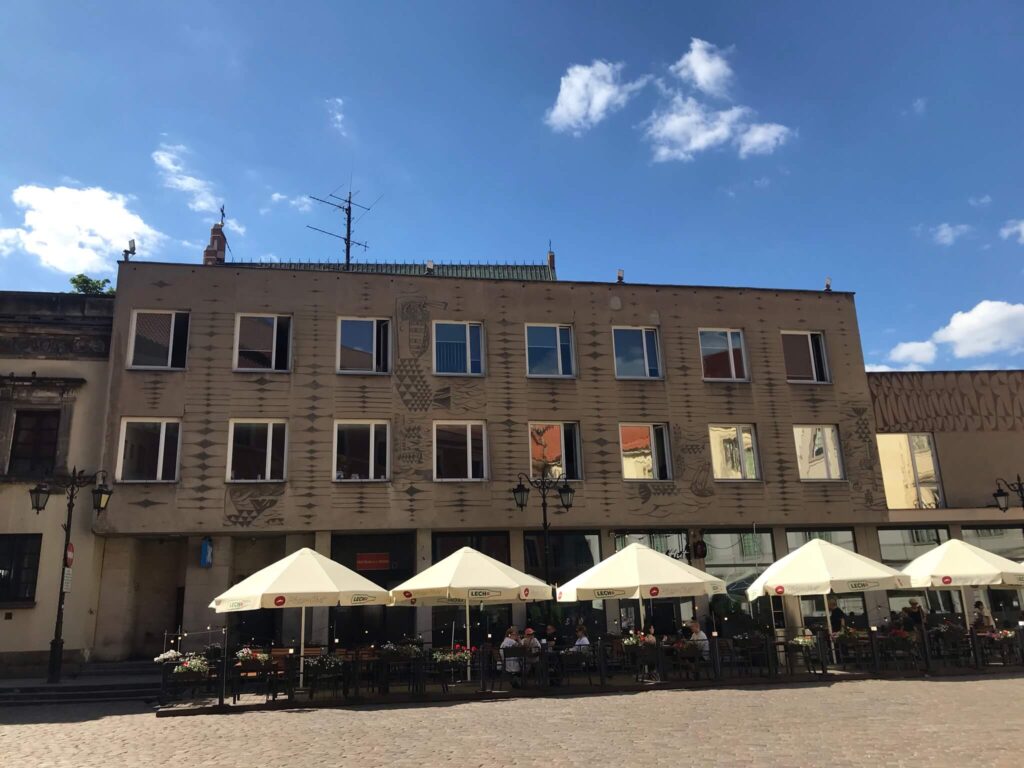
Non-traditional, non-obvious and unusual Mermaids
The aforementioned architect Dominik Merlini is the author of many classicist buildings in Warsaw. One of them is the palace known as Królikarnia (literally Rabbit Warren). It now houses a branch of the National Museum – the Xawery Dunikowski Museum of Sculpture. Here, too, there is a place for the Mermaid, in the form of a statue, of course. It is located at the very entrance to the palace. The Mermaid from Królikarnia has a classicist form, but she is not shown with the customary sword and shield. Instead, she holds a fish and a spiralled shell which she blows. There are several such non-traditional representations of mermaids in Warsaw – one of them is a monument in front of the Praga-Południe District Office, at 274 Grochowska Street. This Mermaid was created in 1973 and its author, sculptor Jerzy Chojnacki, depicted her with a bouquet of flowers in her lowered hands. The sculpture originally stood in a different location – in front of the now-defunct Sawa cinema, whose name refers to the name of the legendary Mermaid. Another non-standard sculpture of a Warsaw mermaid is Karol Tchorek’s 1975 work under the proper name ‘Warsaw Autumn’. It stands at the back of the Fryderyk Chopin University of Music in Bohdan Wodiczko’s square on Tamka Street. The sculptor depicted a violin key here, but its shape is reminiscent of a Mermaid with a round shield. For this reason, it is often referred to as the ‘Musical Mermaid’. It can be admired to the sound of music coming from the windows of the University. Such monuments have often been placed in squares and parks, where they please the eyes of passers-by, but often also have an important utilitarian function. Such a role was given to the 1972 reinforced concrete monument by Ryszard Kozłowski, which stands on the Za Żelazną Bramą estate (literally, the estate Behind the Iron Gate). The Mermaid holds a shield in her left hand and her long tail bends to form a depression, which is also a drinking trough for birds.
There are still many monuments to Mermaids in Warsaw, and they are mentioned in tourist guides and on popular websites. There are also, offered by private companies or agencies, special tourist tours focused specifically on this figure. Sometimes these focus only on the monuments, and sometimes on less obvious monuments associated with her – such as neon signs. Here, it is worth starting the tour at the Museum of Neon Signs at 25 Mińska Street, which has around sixty neon signs in its collection, including objects depicting the Warsaw Mermaid. The most famous is a neon sign with a Mermaid sitting on a book. This composition is a symbol of Warsaw’s libraries. If you decide to borrow a book from any of the city’s libraries in Warsaw, take a peek inside at its first pages. The stamp will look exactly like the Mermaid from the neon sign. In search of other neon signs with Mermaids, it is also worth going to Hoża Street, among others. There, at number 56, you will find the headquarters of the Ambulance Service, and on the façade of the building, a neon sign with a Mermaid floating on the waves. This fantastic creature, in the modern form of a yellow neon sign, also adorns the walls of the Google Campus building at 10 Koneser Square. This is an old storehouse of a former vodka factory converted into a modern centre for entrepreneurs.
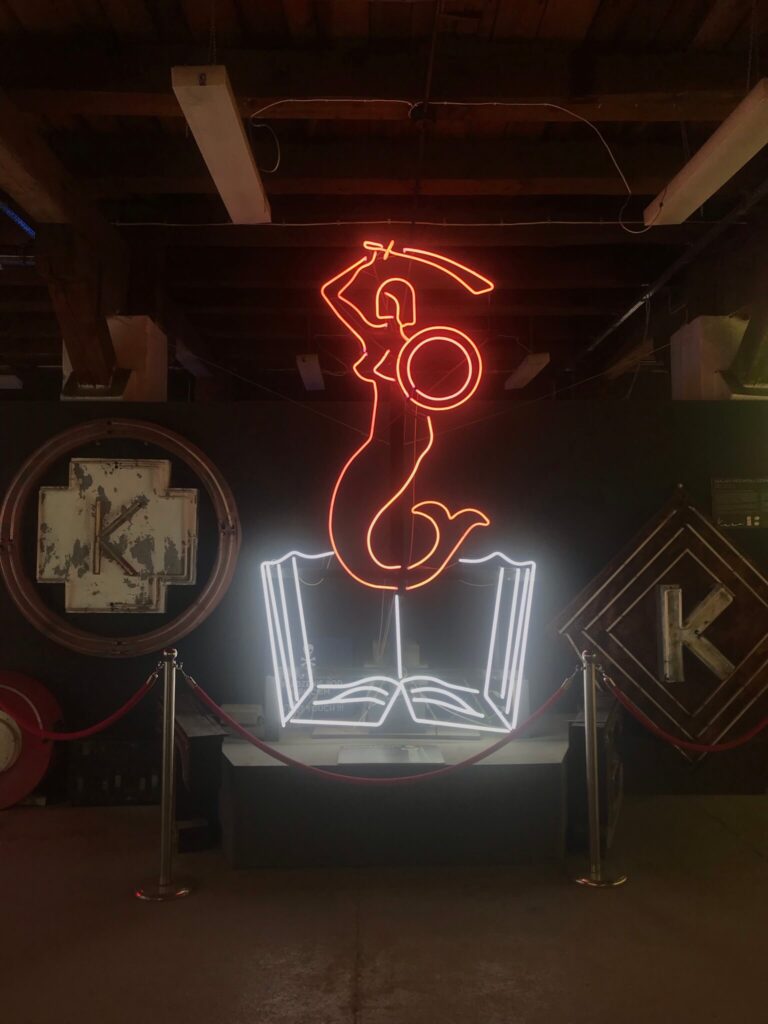
What does a Warsaw Mermaid have in common with Picasso?
An extremely interesting and valuable depiction of a Mermaid, not to be forgotten here, adorned the walls of yet another building, this time a residential one. Its importance is linked to the author of this mural – Pablo Picasso himself. This artist made his only trip to Poland in August 1948 on the occasion of the World Congress of Intellectuals for Peace, held in Wrocław. During this trip he visited several cities, including Warsaw. His guides in the city, which was being rebuilt from the ruins after the war, were a pair of Warsaw architects, Helena and Szymon Syrkus. One of the places they decided to show the Spaniard was a housing estate under construction in the Wola district, functional and modern for the time. Picasso entered one of the unfinished blocks of flats, where, in a one-room flat with a kitchen and a sleeping alcove on the ground floor, he drew a drawing of the Warsaw Mermaid with charcoal on the wall. In Picasso’s version, she was given a hammer instead of a sword to symbolise the construction process. The flat with the mural was located at 48 Deotymy Street (now 4 Priest Jan Sitnik Street). Even after the new tenants moved in, fascination with the work did not diminish and the place was visited by many interested parties, school trips and even important officials and delegations. After a while, the crowd of visitors became too much of a nuisance for the tenants living there, for whom the presence of the work made daily life miserable. In the absence of a decision by officials as to the further fate of the drawing, at the end of 1952 the tenants turned to the housing cooperative with a request to renovate the flat. In August 1953, the Warsaw Housing Cooperative (Warszawska Spółdzielnia Mieszkaniowa) agreed, and Picasso’s drawing was painted over by a room painter hired for the purpose or, according to other accounts, stripped together with the plaster. At present, therefore, the work is only known through photographs. However, this does not mean that it cannot be seen – there are several commemorations of Picasso’s visit to Warsaw and of the drawing itself. In order to see them, it is worth going to Obrońców Street, for example. On the wall of the building at number 28/30, where the artist was hosted by Warsaw painters and sculptors in 1948, a mural repeating the painter’s former work was created in 2017.
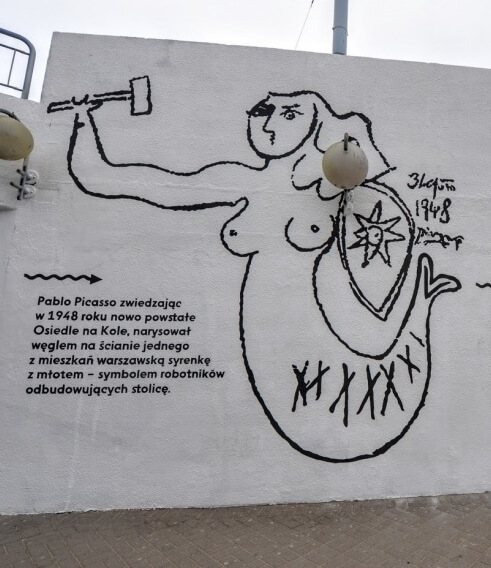
Where else to look for a siren in Warsaw?
The symbol of the Mermaid, however, is not always associated with a faithful representation of this character’s appearance and features. This is evidenced by buildings in Warsaw bearing her name. One of them is the Mermaid Stadium, which is located in the Pola Mokotowskie park, at 10 Batorego Street. It is a small sports facility, built in the first years after the end of World War II. It belonged to the Academic Sports Association of the Warsaw University of Technology, which was part of the Municipal Sports Club “Syrena” until 1963. It used to host primarily sporting events, but over time the stadium also took on the function of a concert stage for popular music and various other cultural events. The most famous of these is the Juwenalia, the annual student days, during which the stadium fills with a crowd of young people. Another form of non-obvious commemoration of the Mermaid is the name of the Polish car brand FSO Syrena (literally, FSO Mermaid). This is a type of passenger car and delivery van produced between 1957 and 1972 by the Fabryka Samochodów Osobowych in Warsaw, and from 1972 to 1983 by the Fabryka Samochodów Małolitrażowych in Bielsko-Biała already under the FSM Syrena brand. Although these iconic vehicles are no longer in production, they are still popular with car enthusiasts. In order to see a Mermaid “on four wheels”, you can go to Warsaw’s Museum of Automotive Industry and Technology “Skarb Narodu”.
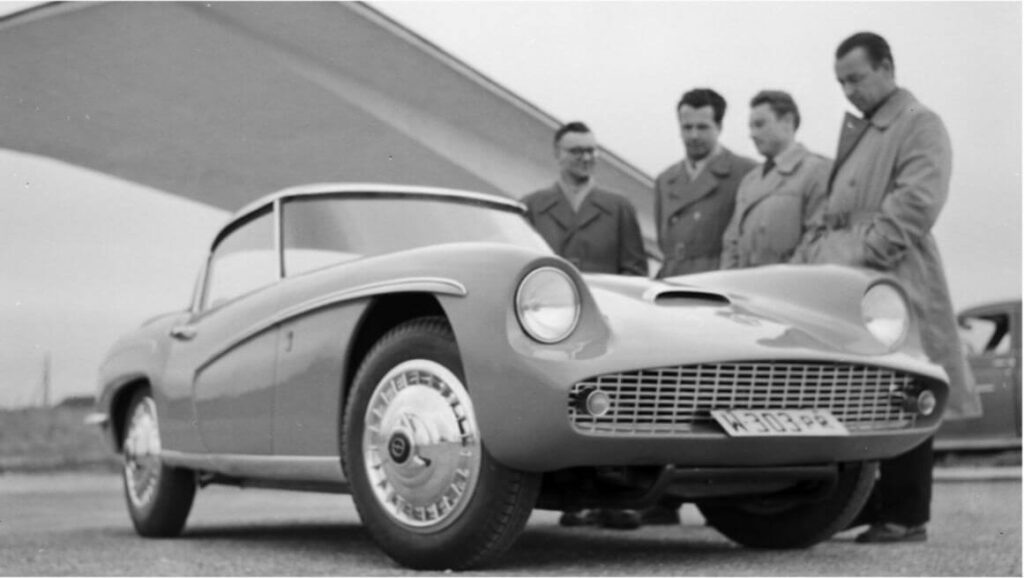
Mermaid parade and the identity of Warsaw’s citizens
Mermaid parade and the identity of Warsaw’s citizens
There are many more references to this legendary character in the Polish capital. She can be spotted, for example, on buses and trams, moving around the city in search of successive representations of the Mermaid. Some of them are very well known and are a fixed point in the Warsaw sightseeing plan. Others remain hidden, but are easy to stumble upon if you know what to look for. However, we can be sure that the Mermaid is an important symbol for Varsovians, one that represents their identity and has the potential to unite the city’s inhabitants. This can be seen, for example, during the annual Mermaid Parade (Parada Syrenki), when individual districts and organisations prepare special platforms with their own creative representation of the Warsaw Mermaid. The event takes place in early June as part of the Warsaw Days. Its main element is the passage of a colourful, noisy parade through Nowy Świat and Krakowskie Przedmieście streets to Castle Square. The fancy-dress costumes from the various districts are then accompanied by performances by Warsaw bands, the city orchestra and a row of old, classic cars. To the delight of the youngest tourists watching the parade, countless soap bubbles float around the long parade and a lively ringleader asks questions about the Warsaw Mermaid to spectators randomly selected from the crowd. The event demonstrates the important nature of the symbol of the Mermaid – her figure has become a form of cultural heritage that manifests itself in the urban fabric in various forms. This heritage is protected in a number of ways – from the restoration of monuments and the placement of endangered monuments in museums, to the naming of important architectural sites after the Mermaid and the organisation of cultural events associated with the Mermaid. One thing is certain – the Varsovians will not soon forget their Mermaid who, according to the words of legend, promised to protect and help them.
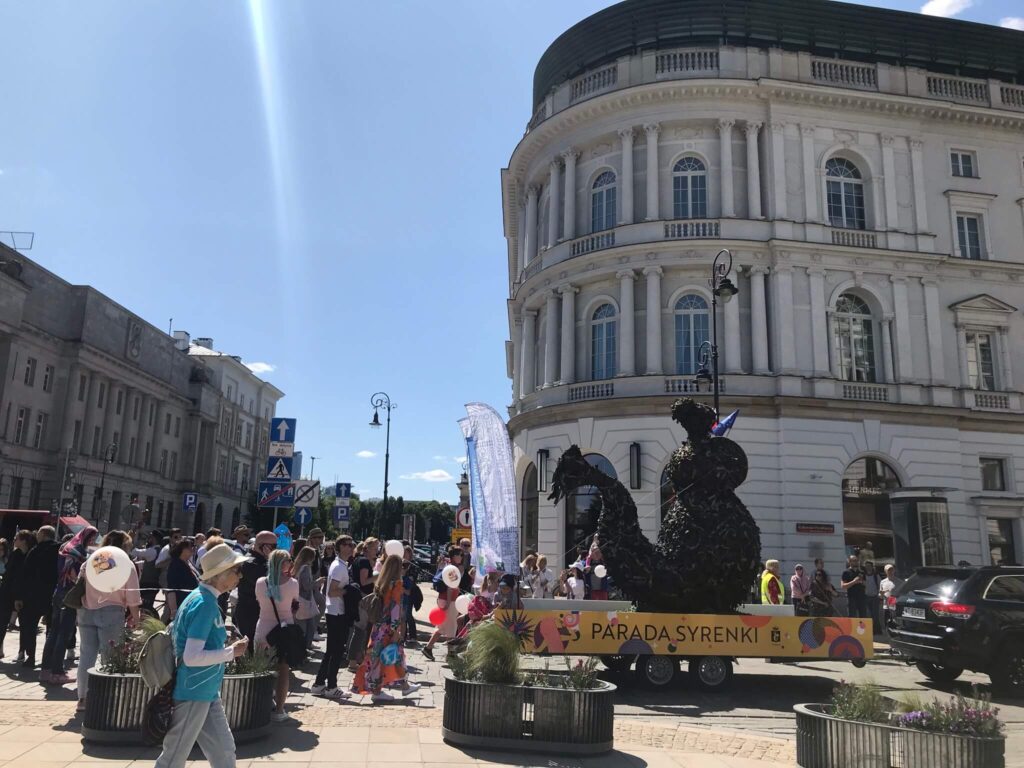
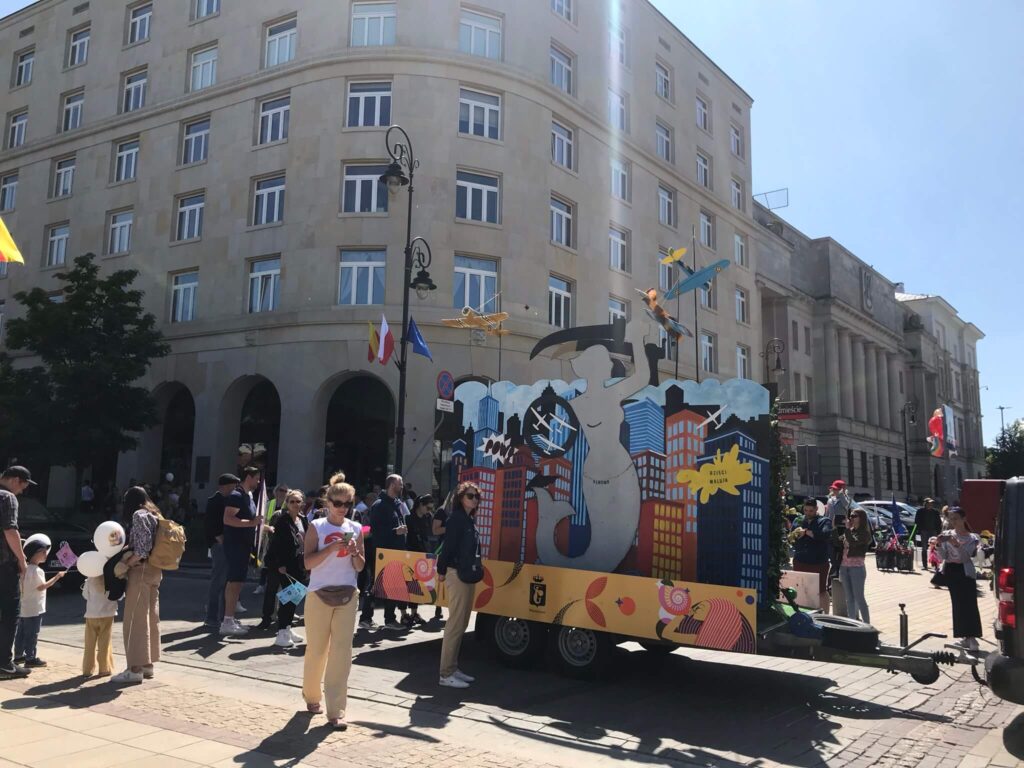
If you wish to contact the author of this article, please send an email to community@europeanheritagetimes.eu
